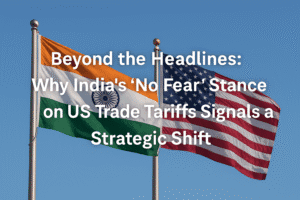Beyond the Headlines: Why India’s “No Fear” Stance on US Trade Tariffs Signals a Strategic Shift
India enters critical US trade talks with unprecedented confidence, anchored in its economic rise and strategic “Viksit Bharat” (Developed India) and “Atmanirbhar Bharat” (Self-Reliant India) visions. As the world’s fifth-largest economy, India leverages its massive market and supply chain importance – exemplified by surpassing China in US smartphone exports.
Recent success securing a UK trade deal demonstrates its ability to negotiate favorable terms aligned with national interests. Crucially, India has established clear non-negotiables: no concessions harming agriculture or labor sectors, no automatic market access for US goods, and a ban on unapproved GM foods. Its proven resilience – defying US pressure on Russian oil imports based on consumer benefit – signals an unwillingness to yield to deadlines or threats.
This stance, backed by recognition of India’s value like Apple’s praise for its workforce, positions it to demand reciprocity rather than accept imposed terms. The negotiations mark a strategic shift where India, prioritizing sovereignty and development goals, engages from strength rather than supplication.

Beyond the Headlines: Why India’s “No Fear” Stance on US Trade Tariffs Signals a Strategic Shift
The recent declaration by India’s Commerce Minister Piyush Goyal – “No Fear, No Pressure” – regarding upcoming trade negotiations with the Trump administration isn’t just political bravado. It reflects a calculated confidence rooted in India’s evolving economic reality and strategic positioning on the global stage. As the US negotiating team prepares for talks in New Delhi on August 25th, understanding the pillars of India’s stance reveals a nation increasingly willing to assert its interests.
The Foundation: Viksit Bharat and Atmanirbhar
Minister Goyal explicitly anchored India’s approach to two key domestic visions:
- Viksit Bharat (Developed India): India’s rise to the world’s fifth-largest economy, projected to become a $5 trillion economy, fundamentally changes its bargaining power. This growth trajectory makes India an indispensable market and a crucial link in global supply chains. The world, including the US, recognizes this momentum.
- Atmanirbhar Bharat (Self-Reliant India): This isn’t isolationism, but strategic resilience. India is signaling it will prioritize domestic industries, particularly labour-intensive sectors and agriculture, and will not accept deals that undermine them for short-term gain. This policy aims to build long-term economic security.
Sources of India’s Negotiating Confidence:
- Economic Gravity: As a trillion-dollar economy with robust growth, India is no longer a supplicant. Its massive consumer market offers leverage. The US needs access as much as India seeks favourable terms. The shift in smartphone exports, where India overtook China in supplying the US market (driven significantly by Apple’s expansion), exemplifies this growing interdependence.
- Demonstrated Deal-Making: The successful conclusion of a trade agreement with the UK serves as a powerful signal. It proves India can negotiate complex deals on its own terms and timeline, boosting its credibility ahead of US talks. This deal shows India isn’t desperate and has alternatives.
- Strategic Autonomy in Action: India’s unwavering stance on Russian oil, despite US penalties, is a case study. The Ministry of External Affairs’ statement – guided by “what is on offer in the markets” – underscores a pragmatic foreign policy prioritizing national interest and consumer welfare over external pressure. This precedent demonstrates India’s willingness to absorb costs to protect core interests.
- Defining Red Lines: India enters negotiations with clear non-negotiables:
- Protecting Agriculture & Labour: No concessions in agriculture that harm farmers, no easy flooding of the Indian market with subsidized US agro-products, and a firm “no” to Genetically Modified (GM) foods without rigorous domestic approval processes. Safeguarding labour-intensive sectors is paramount.
- Consumer Leverage: The government believes the potential loss of access to competitively priced, high-quality Indian goods in the US market could hurt American consumers, providing indirect leverage.
- Quality Recognition: Endorsements like Apple CEO Tim Cook’s public praise for the “unmatched excellence” of Indian manpower bolster India’s position, highlighting its value beyond just low costs.
Beyond the Bilateral: A Multipolar Trade Reality
India’s stance reflects a broader global shift. The US offer of low tariffs to smaller economies like Pakistan and Bangladesh is noted but dismissed as irrelevant to India’s scale and strategic weight. India is positioning itself as a major pole in a multipolar trading world, capable of engaging with multiple blocs and partners without being overly dependent on any single one.
The Challenge Ahead: Walking the Talk
While the “No Fear” mantra is potent, the real test begins on August 25th. Negotiating with a US administration known for its transactional and sometimes unpredictable approach requires both firmness and agility. India must balance protecting sensitive sectors with securing meaningful access for its exports in areas like services, pharmaceuticals, and engineering goods. The key will be translating confidence into concrete outcomes that advance the Viksit Bharat vision without compromising core Atmanirbhar principles.
The Takeaway: A New Chapter in India-US Trade
India’s assertive posture marks a significant evolution. It moves beyond reactive trade diplomacy to proactive strategy based on economic strength and defined national interests. The upcoming talks aren’t just about tariffs; they are a test of how two large democracies navigate complex economic interdependence in an increasingly fragmented global order. India has laid down its markers clearly: it seeks a deal, but only one that respects its developmental imperatives and hard-won economic sovereignty. The world, and particularly Washington, is taking note.
You must be logged in to post a comment.